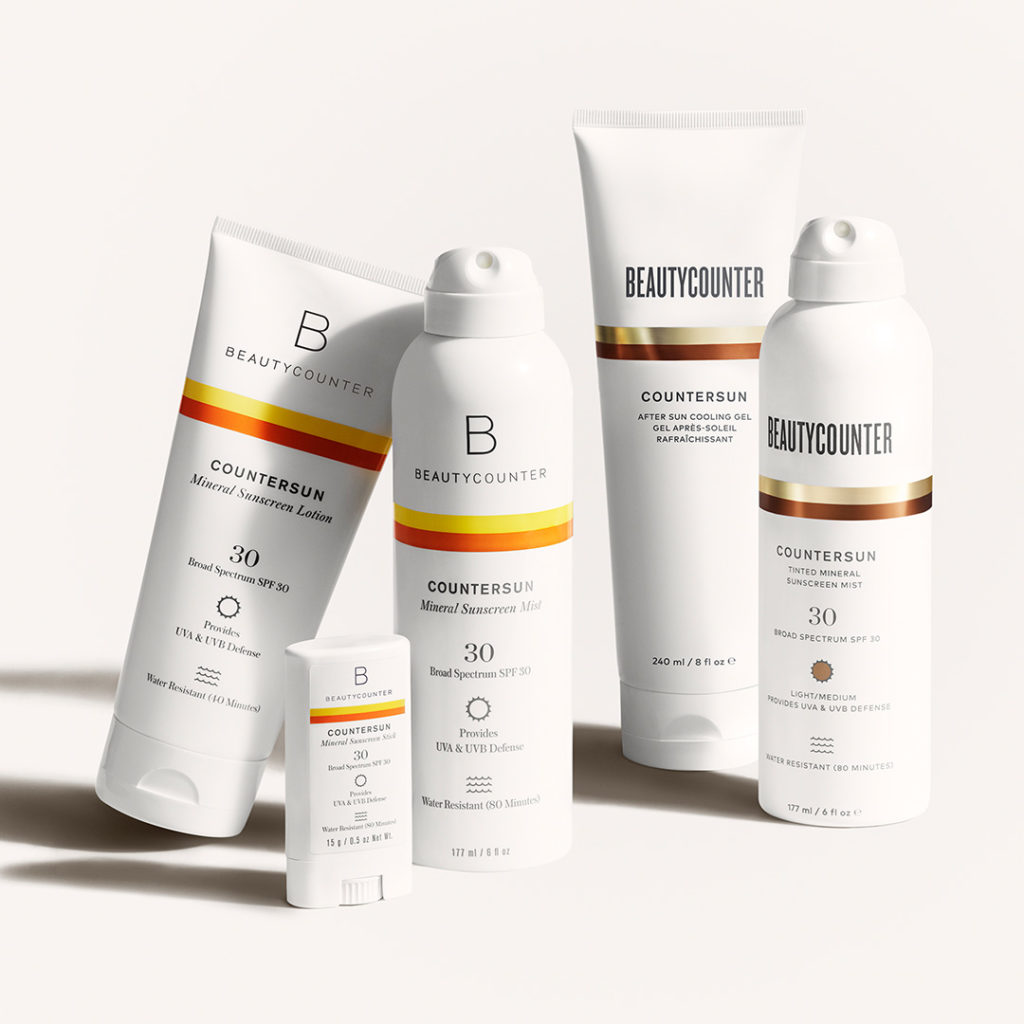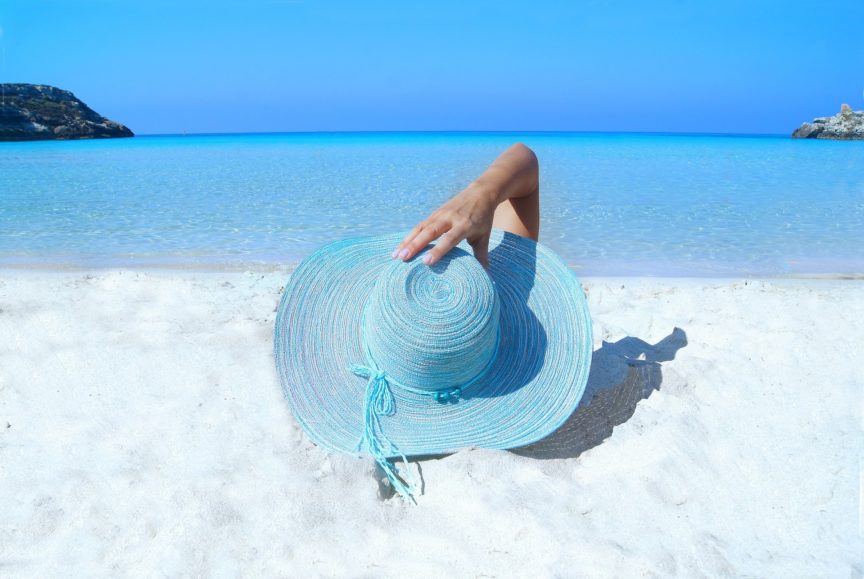
Happy National Sunscreen Day!
Sunscreen is one of the most commonly used personal care products, and not just in the summer months. Most women look for facial moisturizers or foundations that also include SPF because we want to help slow the development of wrinkles and dark spots on our face. For everyone else, we slather it on most of our bodies all summer long in large quantities, and then reapply frequently. Sunscreens often include ingredients that are penetration enhancers that help the product stick to the skin and as a result many sunscreen chemicals are absorbed into the body and can be measured in blood, urine and breast milk samples.
There are two different types of sunscreens on the market: chemical and mineral. Chemical sunscreen is most commonly found on the market, though the number of mineral sunscreens is starting to increase the more that we learn of the toxicity and side effects of chemical sunscreens. It is estimated that 90% of the signs of aging are caused by the sun. More people are diagnosed with skin cancer every year than all other cancers combined. Lab studies show that chemical filters can cause skin irritation and may mimic hormones in the body. This causes a cascade of issues when hormones are disrupted within the body due to external sources. More recent studies show that we do not know enough about chemical sunscreen ingredients to determine that they are safe for our health. In early May of this year a new report provided by the Journal of the American Medical Association about a study conducted by the FDA showed that we absorb high levels of these chemicals into our bloodstream even after one day of use. Considering these results the FDA is finally admitting that the common chemical sunscreen ingredients require more testing to find out the effects of these ingredients and whether they cause cancer, hormone imbalance, etc. They have deemed mineral sunscreens safe, but chemical sunscreens require more testing. You can read more about these findings here. It’s hard to know how long that testing will take, but in the meantime wouldn’t you want to choose a sunscreen that you know is safer for you and the environment?
Let me break down the details about each type of sunscreen, ingredients to avoid and which ingredients are safer.
Chemical Sunscreen:
Chemical sunscreens are technically sun filters and they work by absorbing the sun’s UV energy and releasing it back into the air as heat. They are popular because of they are blendable into the skin and leave a transparent color. The vast majority of sunscreens on the market contain chemical sunscreen ingredients like avobenzone, oxybenzone, octinoxate or octocrylene.
Oxybenzone:
The most widely used in chemical sunscreens, research shows absorption through the skin as well as hormone disruption. Studies show that this chemical is detected in nearly every American, found in mother’s breast milk and 1%-9% skin penetration in lab studies. It is a phytoestrogen that mimics estrogen in the body, a moderate anti-androgen and is associated with altered birth weight in human studies. It also causes relatively high rates of skin allergies. Oxybenzone has also been found to contribute to the collapse of coral reefs and has since been banned in Hawaii. If it can do that to coral reefs, imagine what it can do to your body?
Octinoxate:
Found in mothers’ milk, has less than 1% skin penetration in human and laboratory studies – but that doesn’t mean that it doesn’t absorb or cause harm. Studies show that it mimics hormone like activity, effects the reproductive system and thyroid. Octinoxate also has been shown to contribute to coral reef collapse and has been banned in Hawaii.
Mineral Sunscreen:
These are physical sunscreens that typically include zinc oxide and/or titanium dioxide that sit on the surface of the skin and scatter or reflect the sun’s rays away from the skin.
UVA = aging rays. Present all year round, penetrates clouds and glass and deeper into the skin to cause free radical damages that contributes to premature aging.
UVB = burning rays. The primary cause of sunburn, easier to recognize and we can see and feel the damage it causes.
Broad Spectrum = an effective sunscreen is broad spectrum, or provides protection against both UVA and UVB rays. This ensures that the sunscreen provides protection against both sunburn and premature skin aging.
SPF = Sun Protection Factor, is the measurement of the sunscreen’s level of defense against sunburn caused primarily by UVB rays.
SPF 15 – Blocks 93% of UVB rays
SPF 30 – Blocks 97% of UVB rays
SPF 50 – Blocks 98% of UVB rays
Water Resistant vs. Waterproof
There is a difference between water resistant and waterproof. Water resistant means that the sunscreen resists removal while in water and are durable against wash off but none are 100% insusceptible to it. This is why sunscreens show that they are water resistant for a certain amount of time and the directions say to reapply every 2 hours or more often if you are in the water. There is no such thing as waterproof sunscreen.
How to pick a better sunscreen:
The EWG puts out a sunscreen guide every year. You can see the 2019 guide here. The EWG has one of the largest databases for products and product ingredients available that is also searchable by product or individual ingredient. It is a great way to evaluate the current products that you have as well as a guide to help you figure out what safer products to choose.
CHECK YOUR INGREDIENTS:
Just because a sunscreen is labeled as “mineral” does not mean that it doesn’t have toxic chemicals in it. There is no regulation on labeling, so natural doesn’t necessarily mean it’s non-toxic either. You have to check the ingredients!
Ingredients to avoid: oxybenzone, octinoxate, homosalate, octisalate,
octocrylene, and retinol. These are all chemical ingredients that pose cancer, endocrine, skin allergy and inhalation risks.
Spray Sunscreen: Continuous spray sunscreens are also toxic and I recommend avoiding if they use aerosol. These products are not great for us or the environment. Choose products that note they are non-aerosol.
Ingredients to choose: zinc oxide, titanium dioxide. Look for non-nano zinc, this means the particles are too big to be inhaled.
Look for: Broad Spectrum, under 50 SPF (higher doesn’t mean better), non-aerosol spray sunscreens.
Always remember to follow the directions on the bottle. Mineral sunscreens need to be applied at least every 2 hours and maybe more often if you are in and out of the water. Typically mineral sunscreens fail to work because of user error and not applying frequently enough. When in doubt, cover up! There’s no shame in wearing a cute cover up or rash guard to cover your skin during the hottest parts of the day. Wide brimmed hats, loose fitting long sleeves or finding shade are acceptable choices. Don’t forget your chap stick and sunglasses too, you don’t want your lips or eyeballs getting burned.
My Favorite Sunscreens:
Beautycounter:

Beautycounter is at the top of my list because their sunscreen is extremely clean (we avoid 1500 potentially harmful ingredients in all of our products) and it WORKS. It is concentrated and extremely effective. I took a 6 oz bottle of the lotion to Lake Powell for a week last summer, applied it multiple times a day, shared it and it is still not empty. Their spray sunscreen is also mineral, formulated with a non-aerosol air pump and sprays on white but rubs in clear. I am naturally tan but this sunscreen rubs in great with no residue. It is formulated with California poppy and non-nano zinc, protects against UVA, UVB and blue light (most responsible for aging), and is reef friend and ocean safe. We have a lotion, spray, sunscreen stick, TINTED sunscreen and an after sun cooling gel. Check out the Countersun line here.
There is also a MEMORIAL DAY PROMOTION going right now! Until Tuesday 5/28 if you spend $125 you get a FREE 3 oz Countersun Sunscreen Spray and a FREE 1oz Countersun Sunscreen Lotion! This is a GREAT deal to try the product for free and stock up on some of my other favorite products! Reach out with any product questions, recommendations or if you want to try a sample first! You can contact me via the links here or at bernie@freshorbust.com.
*I am a Beautycounter consultant and receive commission off of your purchases.
Bare Republic: This comes in a lotion, stick and spray and has GREAT ingredients. Doesn’t leave a white cast. Even my picky husband loves it.
Badger Mineral Sunscreen: Great ingredients and effective, but leaves a bit of a white cast on skin.
Other great brands: Goddess Garden, Alba Botanica, Aveeno (baby and kid lines). A lot of traditionally chemical brands are stepping up their game and reformulating with better ingredients too, like Neutrogena. Just remember to check the EWG list and your ingredient labels!
I hope this helps you understand the importance of choosing safer sunscreen for both yourself, your kiddos and the environment. It’s important that we know what is in our products and how they effect our health. Also, I hope this makes it easier for you. It is not as hard as it sounds like it is and there are so many new great products on the market as consumer demand is shifting. Our voices matter and they are making change! Let’s keep it up!
Now, let’s get summer started!!!

